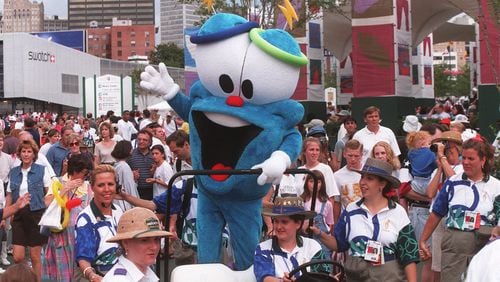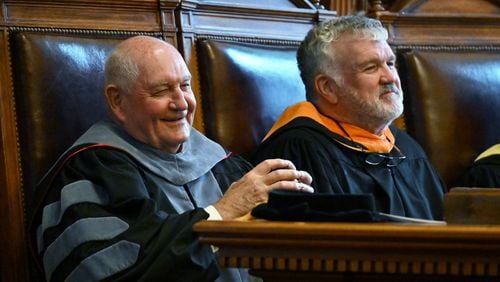John Ryan’s doing just fine, thank you very much.
No lingering signs of resentment or trauma surround the Sandy Springs resident, whose Dagnabit! animation studio’s clients include Delta Air Lines, Coca Cola, Hallmark Channel and others. A framed copy of the winning poster he designed for the 2015 Atlanta Jazz Festival hangs on one wall of his gracious home.
Meanwhile, tucked away in a box downstairs is a stuffed doll version of the 1996 Atlanta Olympic mascot character that Ryan created to initial acclaim, only to see it become an object of fierce mockery and a frantic redesign effort he wasn’t involved in:
Izzy.
Whatizit.
Whatever.
“It was going to be what it was going to be,” Ryan chuckled softly about how things turned out.
It was just one of countless tasks facing the Billy Payne-led Atlanta Committee for the Olympic Games: Come up with a mascot. Ten firms wound up submitting designs. Ryan, who was 41 at the time and senior director of the animation division at Crawford Communications in Atlanta, won for his electric blue, oval-shaped character that sported an enormous grin, lightning bolt eyebrows and three Olympic rings spouting off its rear end (the other two rings were above its eyes). It had the power to “morph,” transforming into different costumes with props representing the various sports.
Ryan named his creation “Hi-Rez,” in honor of the burgeoning tech industry in Atlanta and its pioneering use of things like computer-generated imaging.
"Atlanta was being groomed as a sort of Silicon Valley East," Ryan explained, using the half-joking term "roadkill" to describe the quaint or comical animal characters that had been the basis for many previous Olympic host cities' mascots. "Did we really want to be represented by that?"
After his design’s selection, Ryan and a Crawford team had about five weeks to create a 3-minute film to be used to introduce the mascot to the world media at the 1992 Summer Olympic Games in Barcelona. Meanwhile, ACOG got to work on a new name.
“The logical question that you would ask on seeing it is, ‘What is it?’” Payne told Atlanta magazine. “I guess we just said, ‘Well, we should just put it into one word.’”
“It did feel temporary,” Ryan said in retrospect about the new name. “You ask a question, you have to answer it.”
Plenty of people did. And not so nicely. Almost as soon as poor little Whatizit was unveiled during the Barcelona closing ceremonies, the name-calling began: a “blue maggot.” “Billy’s folly.” “A sperm in sneakers.”
And this, from legendary Atlanta Journal-Constitution columnist Lewis Grizzard:
“I have no idea what it is, but if a bunch of them got into the woodwork of your house, I think they would try to eat it.”
ACOG loyally stuck up for Whatizit for a while, but by the following spring, a redesign was underway. After working with marketing professionals and focus groups and creating a Kids Advisory Council to come up with a new name, what emerged by the fall of 1993 was “Izzy,” a slightly warmer and friendlier mascot with some muscles and a more expressive face.
Ryan said he found out about the changes when an ACOG official came to Crawford’s offices with drawings of the newly refined character. He’s remarkably sanguine about it now: “As artists, we face rejection all the time.”
You could even argue his Hi-Rez was just a portent of what was to come, mascot-wise. For instance, the highly successful 2012 London Summer Olympics offered a pair of one-eyed characters (inside was a camera) whose skin was actually polished steel that could reflect people’s appearances. Even earlier, Javier Mariscal, the renowned Barcelona designer who created the much-loved 1992 Summer Games sheepdog mascot, Cobi, said he’d gone from initially considering Whatizit “too computerized” to admiring it as endlessly morphable.
“It’s easy to see him in life, to see him move,” Mariscal told the AJC in 1993.
“It was ahead of its time,” Ryan agreed with a smile. “But it’s not something I want on my tombstone.”
MORE
About the Author






